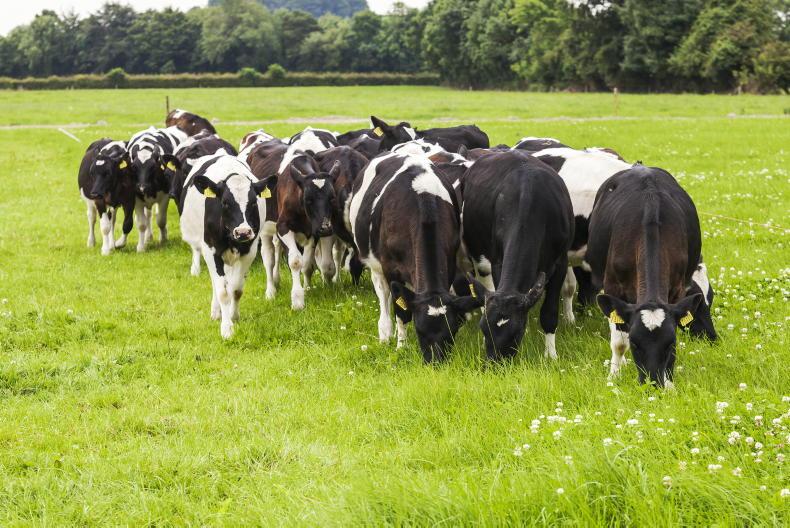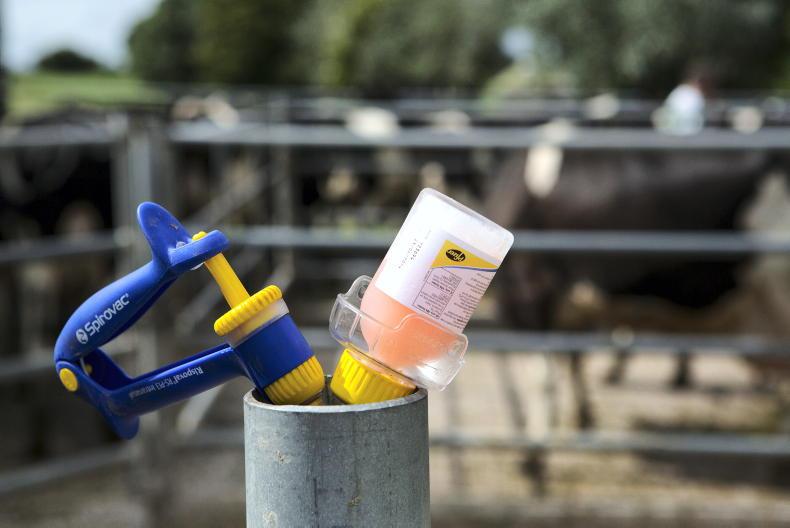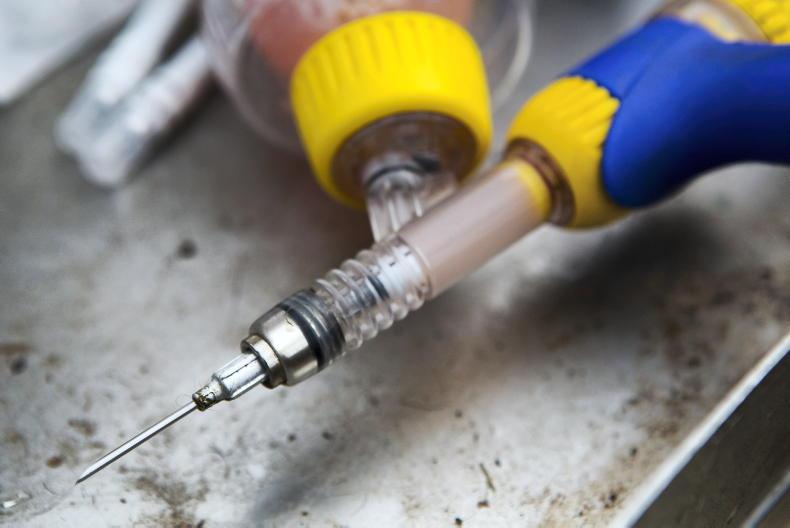The launch of the findings from a European Innovation Programme (EIP)-funded study took place across the autumn of 2022 and 2023. The project was based around finding a baseline level of dung beetles on dairy farms across Co Laois.
The aim was to implement measures to increase dung beetle populations in soil and a further goal to reduce animal remedy usage.
EIP projects are aimed at bringing research and new ideas from the bottom up, ran by farmers.
The O’Moore EIP group first emerged in February 2021, when Laois dairy farmer Bruce Thompson brought the idea to the O’Moore dairy discussion group.
Bruce has previously completed a Nuffield scholarship in ‘anthelmintic resistance control measures incorporating pastoral management and dung beetles to increase biodiversity’.
Fourteen farmers from the discussion group joined him but the project doesn’t suit everyone in the group, as some were contract-rearing calves.
The project is co-ordinated by Lorcan Dooley, dairy adviser at Teagasc. Other participants in the project are Munster Technological University (MTU), Killian Kelly, Peter Stuart and Hugh Patrick O’Connor.
Also speaking on the night was Joris Somers, animal health and hygiene manager of Tírlán.
The current state of insect population in Irish grasslands is uncertain. There is growing concern about the resistance to wormers in livestock and these are known to negatively impact insect populations. With this in mind, the O’Moore group decided to further study this topic.
The process
Apart from Bruce’s experience in insects through his Nuffield scholarship, the other participants had limited knowledge on the topic at the time. The group attended many training sessions with experts to educate themselves around the topic.
This ensured a clear goal for the project and a greater vision of the issues in which farmers are facing.
In order to determine which calves needed to be dosed, they were all weighed. Calves that were under target were dosed. Calves were weighed when turned out to grass. Every six weeks they were reweighed to track performance.
Dung samples were also taken every four weeks. This established the levels of parasites in the calves.
While it was important to do this, the farmers in the project found it was important they had the knowledge in how to interpret the results, and how to act on this.
Traffic light grazing
Traffic light grazing is something the group adopted for grazing calves as they are the most susceptible animals on the farm. Traffic light grazing is based around the burden of worms in the specific paddocks.
It is important to note that calves have a higher rate of fouling than cows. Their immune system hasn’t fully developed, leading to depositing more eggs, as they can’t interrupt the lifecycle of parasites.
Research throughout the project showed that there are two types of parasite resistance: adaptive and innate. Innate is a genetic resistance the calves have from birth. Recording data of cases of disease will help ICBF to improve this over time.
Adaptive is a resistance built up over time. By using the traffic light grazing technique, this slowly exposes calves to parasites. This gradual exposure helps build up their resistance.

Dung beetles offer huge potential in reducing anthelmintic resistance on Irish farms.
A green, amber and red system is used, where green is low risk, amber is medium to little risk and red is high risk of parasites.
The farmers have a colour-coded map of their farm with a colour on each paddock. This helps farmers to make a quick decision on where to put calves.
Preferably, calves should be going to silage ground or land grazed by other animals
It is important that calves stay away from high-risk paddocks for the first half of the grazing season. Preferably, calves should be going to silage ground or land grazed by other animals. Calves grazing the paddock where they were trained in the previous year is also considered a high-risk paddock.
Larvae tend to live in the bottom 5cm of grass in a paddock. Pushing calves to graze out a paddock is another factor that will further increase risk of disease.
If a paddock is in the red zone for high risk, how do farmers get it back to green or amber? There are three known ways in which a paddock can be cleaned, such as grazing with high-resistance animals such as cows, reseeding the paddock or giving the paddock time to recover.
Once faecal tests go over 250epg, farmers should begin thinking about intervening by dosing to avoid a negative effect on performance. It was also said that farmers should consider to rotate products to help with the emerging issue around resistance.
Lactating cows are limited to using eprinomectin, which is a clear wormer.
Other wormers, such as white wormers, can be used on dry cows and young stock, while yellow wormers can be used on young stock only. With this in mind, rotating these products around for calves is crucial to limiting resistance.
Accuracy
Selective therapy all comes back to the data gathered. The more often it is measured, the more accurate farmers can be. This is where faecal sampling and weighing comes into play.
Once the egg count goes above 250epg and calves’ daily weight gain drops below 0.7kg/day, these calves should be treated.
It should be noted that the daily weight gain target should be adjusted to the calf’s maintenance figure, as larger animals should have a higher weight gain.
Once treated, these calves should be separated from the untreated calves. Treated calves should not be moved to a green paddock. They should go to an amber or red paddock for three to four days.
Resistant parasites
This will ensure resistant parasites left behind in the gut have an opportunity to mate with susceptible parasites.
The combination of weighing and faecal testing is most important as information on the night showed that 80% of the parasites are in 20% of the calves, meaning weighing and testing need to work together.

Dung beetles are small and jet black in colour.
So where do dung beetles come into play? There are many benefits to having dung beetles on farms. The main one, in this scenario, is their ability to reduce parasite populations and flies in our soils.
Other benefits are their ability to dry dung paths, which allows nutrients to get into the soil faster, but also prevents grass growth from being hindered.
There are two types of dung beetles, those that live in the grass and there is also a burrowing species which tunnel into the soil, improving aeration and soil structure.
All of these benefits combined can also have a positive effect on water quality. As part of tracking the population of dung beetles on farms, MTU students were involved throughout autumn 2022 and 2023 to get a clearer picture of how many dung beetles there are.
There were five baited pitfall traps per farm setup in late autumn 2022 by the students in MTU. This was then repeated a total of four times up to summer 2023.
The samples were then sent off to the lab in MTU Kerry, they were carefully cleaned and separated where students used an identification key to see the levels of dung beetles on the farms.
Results from the trial showed that there were over 45 insect species captured in the live baits. A total of 8,300 out of 21,600 individuals were dung beetles.
The launch of the findings from a European Innovation Programme (EIP)-funded study took place across the autumn of 2022 and 2023. The project was based around finding a baseline level of dung beetles on dairy farms across Co Laois.
The aim was to implement measures to increase dung beetle populations in soil and a further goal to reduce animal remedy usage.
EIP projects are aimed at bringing research and new ideas from the bottom up, ran by farmers.
The O’Moore EIP group first emerged in February 2021, when Laois dairy farmer Bruce Thompson brought the idea to the O’Moore dairy discussion group.
Bruce has previously completed a Nuffield scholarship in ‘anthelmintic resistance control measures incorporating pastoral management and dung beetles to increase biodiversity’.
Fourteen farmers from the discussion group joined him but the project doesn’t suit everyone in the group, as some were contract-rearing calves.
The project is co-ordinated by Lorcan Dooley, dairy adviser at Teagasc. Other participants in the project are Munster Technological University (MTU), Killian Kelly, Peter Stuart and Hugh Patrick O’Connor.
Also speaking on the night was Joris Somers, animal health and hygiene manager of Tírlán.
The current state of insect population in Irish grasslands is uncertain. There is growing concern about the resistance to wormers in livestock and these are known to negatively impact insect populations. With this in mind, the O’Moore group decided to further study this topic.
The process
Apart from Bruce’s experience in insects through his Nuffield scholarship, the other participants had limited knowledge on the topic at the time. The group attended many training sessions with experts to educate themselves around the topic.
This ensured a clear goal for the project and a greater vision of the issues in which farmers are facing.
In order to determine which calves needed to be dosed, they were all weighed. Calves that were under target were dosed. Calves were weighed when turned out to grass. Every six weeks they were reweighed to track performance.
Dung samples were also taken every four weeks. This established the levels of parasites in the calves.
While it was important to do this, the farmers in the project found it was important they had the knowledge in how to interpret the results, and how to act on this.
Traffic light grazing
Traffic light grazing is something the group adopted for grazing calves as they are the most susceptible animals on the farm. Traffic light grazing is based around the burden of worms in the specific paddocks.
It is important to note that calves have a higher rate of fouling than cows. Their immune system hasn’t fully developed, leading to depositing more eggs, as they can’t interrupt the lifecycle of parasites.
Research throughout the project showed that there are two types of parasite resistance: adaptive and innate. Innate is a genetic resistance the calves have from birth. Recording data of cases of disease will help ICBF to improve this over time.
Adaptive is a resistance built up over time. By using the traffic light grazing technique, this slowly exposes calves to parasites. This gradual exposure helps build up their resistance.

Dung beetles offer huge potential in reducing anthelmintic resistance on Irish farms.
A green, amber and red system is used, where green is low risk, amber is medium to little risk and red is high risk of parasites.
The farmers have a colour-coded map of their farm with a colour on each paddock. This helps farmers to make a quick decision on where to put calves.
Preferably, calves should be going to silage ground or land grazed by other animals
It is important that calves stay away from high-risk paddocks for the first half of the grazing season. Preferably, calves should be going to silage ground or land grazed by other animals. Calves grazing the paddock where they were trained in the previous year is also considered a high-risk paddock.
Larvae tend to live in the bottom 5cm of grass in a paddock. Pushing calves to graze out a paddock is another factor that will further increase risk of disease.
If a paddock is in the red zone for high risk, how do farmers get it back to green or amber? There are three known ways in which a paddock can be cleaned, such as grazing with high-resistance animals such as cows, reseeding the paddock or giving the paddock time to recover.
Once faecal tests go over 250epg, farmers should begin thinking about intervening by dosing to avoid a negative effect on performance. It was also said that farmers should consider to rotate products to help with the emerging issue around resistance.
Lactating cows are limited to using eprinomectin, which is a clear wormer.
Other wormers, such as white wormers, can be used on dry cows and young stock, while yellow wormers can be used on young stock only. With this in mind, rotating these products around for calves is crucial to limiting resistance.
Accuracy
Selective therapy all comes back to the data gathered. The more often it is measured, the more accurate farmers can be. This is where faecal sampling and weighing comes into play.
Once the egg count goes above 250epg and calves’ daily weight gain drops below 0.7kg/day, these calves should be treated.
It should be noted that the daily weight gain target should be adjusted to the calf’s maintenance figure, as larger animals should have a higher weight gain.
Once treated, these calves should be separated from the untreated calves. Treated calves should not be moved to a green paddock. They should go to an amber or red paddock for three to four days.
Resistant parasites
This will ensure resistant parasites left behind in the gut have an opportunity to mate with susceptible parasites.
The combination of weighing and faecal testing is most important as information on the night showed that 80% of the parasites are in 20% of the calves, meaning weighing and testing need to work together.

Dung beetles are small and jet black in colour.
So where do dung beetles come into play? There are many benefits to having dung beetles on farms. The main one, in this scenario, is their ability to reduce parasite populations and flies in our soils.
Other benefits are their ability to dry dung paths, which allows nutrients to get into the soil faster, but also prevents grass growth from being hindered.
There are two types of dung beetles, those that live in the grass and there is also a burrowing species which tunnel into the soil, improving aeration and soil structure.
All of these benefits combined can also have a positive effect on water quality. As part of tracking the population of dung beetles on farms, MTU students were involved throughout autumn 2022 and 2023 to get a clearer picture of how many dung beetles there are.
There were five baited pitfall traps per farm setup in late autumn 2022 by the students in MTU. This was then repeated a total of four times up to summer 2023.
The samples were then sent off to the lab in MTU Kerry, they were carefully cleaned and separated where students used an identification key to see the levels of dung beetles on the farms.
Results from the trial showed that there were over 45 insect species captured in the live baits. A total of 8,300 out of 21,600 individuals were dung beetles.












SHARING OPTIONS